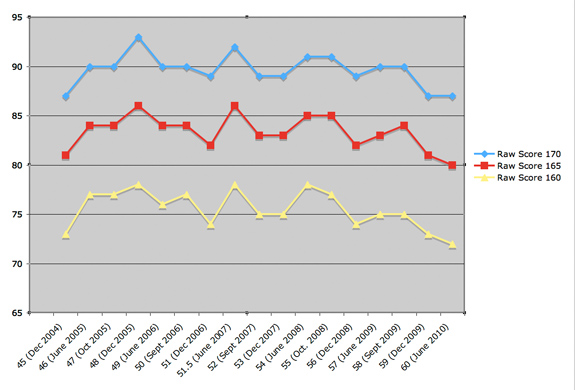October 2010 LSAT Scores Released! Curve Analysis
- by
- Oct 30, 2010
- Analysis of Previous LSATs, LSAT
- Reviewed by: Matt Riley

 When I opened my eyes this morning, I knew something was different. LA traffic was muted. Oprah was doing a special that didn’t involve Dr. Phil. Somewhere in Schenectady, a student executed a series of cartwheels on a linoleum floor. It can only mean one thing.
When I opened my eyes this morning, I knew something was different. LA traffic was muted. Oprah was doing a special that didn’t involve Dr. Phil. Somewhere in Schenectady, a student executed a series of cartwheels on a linoleum floor. It can only mean one thing.
October LSAT scores are out.
And the question on everyone’s mind is…how was the curve? The short answer is that it was friendly. Which means it was a bit more pleasant than what we were expecting based off of our October 2010 LSAT recap responses.
Out of 101 questions, you could miss 11 or 12 for a 170, 18 or 19 for a 165, and 26 or 27 for a 160.
In order to compare how the October 2010 LSAT stacked up against other LSAT’s, and to give you something to do other than refresh your inbox every three seconds, we’ve tracked the curves over the last five years.

Let’s talk for a moment about December 2004. Otherwise known as the last time, in a long time, that you could miss twelve answers and still score a 170 on the LSAT. After December 2004, life got steadily rougher, culminating in the infamous December 2005 LSAT, where you could miss eight to get a 170. Eight. I have more toes than that.
After that, the number crept upward again until June 2007 (damn you, entrance of comparative reading) where another “only eight misses allowed for a 170” moment occurred. Then, in December 2009 we reach the hallowed ground of minus fourteen for a 170 and minus twenty eight (28!) for a 160. Imagine any other exam where you can miss 28 and receive a median score for a top-50 graduate school.
Is there anything intelligible to say about any of this? Are there trends to be located and discussed? And why are you hitting the refresh button when g-mail updates your inbox automatically?
We at Blueprint LSAT Prep thought that surely there would be some correlation between the recession and the LSAT curve. All those influx of people running back to law school should have some kind of impact. But the truth is, the test has been fairly consistent.
For the last five years, you can essentially miss roughly ten questions and score a 170 on the LSAT. Some administrations you get a ball buster and can only miss 8 or 9, but sometimes you get an early holiday present and can miss twelve or more. For a 160, you can miss roughly 25, and so on.
Which is as it should be. After all, the entire purpose of a standardized test is to be, well, standardized. With so many different GPAs across so many different kinds of majors, the LSAT is supposed to let admissions officers know how you stack up on essentially the same test on essentially the same day. Accordingly, lots and lots of effort goes into this endeavor so it’s not particularly surprising that they’ve succeeded.
So when you’re looking at the results of the October LSAT, or contemplating the upcoming December LSAT, the key is not that you want a test with an easier curve. The key is that, on a test where your score is dependent on how well you do in relation to everyone else taking the test, you have to prepare better than everyone else. And be really happy that you didn’t take the LSAT in December 2005.
Check out our discussion board for more conversation about the test and curve.
Search the Blog

Free LSAT Practice Account
Sign up for a free Blueprint LSAT account and get access to a free trial of the Self-Paced Course and a free practice LSAT with a detailed score report, mind-blowing analytics, and explanatory videos.
Learn More
Popular Posts
-
logic games Game Over: LSAC Says Farewell to Logic Games
-
General LSAT Advice How to Get a 180 on the LSAT
-
Entertainment Revisiting Elle's LSAT Journey from Legally Blonde








